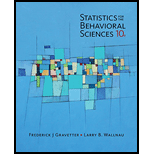
Concept explainers
In the Chapter Preview we described a study showing that students had more academic problems following nights with less than average sleep compared to nights with more than average sleep (Gillcn-O’Neel. Huynh, & Fuligni, 2013). Suppose a researcher is attempting to replicate this study using a sample of
| Number of Academic Problems | ||
| Student | Following Nights | |
with Above
Average Sleep
with Below
Average Sleep
a. Treat the data as if the scores are from an independent-measures study using two separate samples, each with
b. Now assume that the data are from a repeated-measures study using the same sample of is
n=8 n=8
Is there a significant difference between the two sets of scores by using an independent-measures design and then by using repeated measures design.
Answer to Problem 21P
- Using an independent-measures design:
- Using repeated measures design:
STEP 1: State the hypotheses. In symbols, the null and alternative hypotheses are:
STEP 2: Locate the critical region. The critical value of t values for the critical region are
STEP 3: Compute the test statistic. The test statistic is
STEP 4: Make a decision about the null hypothesis. We cannot conclude that there is a significant difference between the two sets of scores by using an independent-measures design.
STEP 1: State the hypotheses. In symbols, the null and alternative hypotheses are:
STEP 2: Locate the critical region. The critical value of t values for the critical region are
STEP 3: Compute the test statistic. The test statistic is
STEP 4: Make a decision about the null hypothesis. We can conclude that there is a significant difference between the two sets of scores by using repeated measures design.
Explanation of Solution
We are given to use a two-tailed test. That's why alternative hypothesis has
The critical value of t values for the critical region are
The critical value of t values for the critical region are
Given:
The table that summarizes the scores for a sample of
Formula used:
Calculation:
- Using an independent-measures design:
- Using repeated measures design:
STEP 1: State the hypotheses. The null hypothesis states that there is no difference between the two sets of scores. In symbols:
The alternative hypothesis states that there is a significant difference between the two sets of scores. In symbols:
STEP 2: Locate the critical region. Degree of freedom is:
STEP 3: Compute the test statistic. The data are as follows:
| Participant | Above Average Sleep |
Below Average Sleep |
||
| A | 10 | 13 | 9 | 16 |
| B | 8 | 6 | 1 | 9 |
| C | 5 | 9 | 4 | 0 |
| D | 5 | 6 | 4 | 9 |
| E | 4 | 6 | 9 | 9 |
| F | 10 | 14 | 9 | 25 |
| G | 11 | 13 | 16 | 16 |
| H | 3 | 5 | 16 | 16 |
The mean of the above average sleep group is:
The mean of the above below sleep group is:
The pooled variance is:
The standard error for the mean difference is:
The test statistic is:
STEP 4: Make a decision about the null hypothesis. Since test statistic does not fall outside the critical region, fail to reject the null hypothesis. We cannot conclude that there is a significant difference between the two sets of scores by using an independent-measures design.
STEP 1: State the hypotheses. The null hypothesis states that there is no difference between the two sets of scores. In symbols:
The alternative hypothesis states that there is a significant difference between the two sets of scores. In symbols:
STEP 2: Locate the critical region. Degree of freedom is:
STEP 3: Compute the test statistic. The data are as follows:
| Participant | Above Average Sleep |
Below Average Sleep |
Difference |
|
| A | 10 | 13 | 3 | 1 |
| B | 8 | 6 | -2 | 16 |
| C | 5 | 9 | 4 | 4 |
| D | 5 | 6 | 1 | 1 |
| E | 4 | 6 | 2 | 0 |
| F | 10 | 14 | 4 | 4 |
| G | 11 | 13 | 2 | 0 |
| H | 3 | 5 | 2 | 0 |
The standard deviation of the difference between the two sets of scores is:
The test statistic is:
STEP 4: Make a decision about the null hypothesis. Since test statistic falls outside the critical region, reject the null hypothesis. We can conclude that there is a significant difference between the two sets of scores.
Conclusion:
- We cannot conclude that there is a significant difference between the two sets of scores by using an independent-measures design.
- We can conclude that there is a significant difference between the two sets of scores by using repeated measures design.
Want to see more full solutions like this?
Chapter 11 Solutions
Statistics for The Behavioral Sciences (MindTap Course List)
 Glencoe Algebra 1, Student Edition, 9780079039897...AlgebraISBN:9780079039897Author:CarterPublisher:McGraw Hill
Glencoe Algebra 1, Student Edition, 9780079039897...AlgebraISBN:9780079039897Author:CarterPublisher:McGraw Hill Holt Mcdougal Larson Pre-algebra: Student Edition...AlgebraISBN:9780547587776Author:HOLT MCDOUGALPublisher:HOLT MCDOUGAL
Holt Mcdougal Larson Pre-algebra: Student Edition...AlgebraISBN:9780547587776Author:HOLT MCDOUGALPublisher:HOLT MCDOUGAL College Algebra (MindTap Course List)AlgebraISBN:9781305652231Author:R. David Gustafson, Jeff HughesPublisher:Cengage Learning
College Algebra (MindTap Course List)AlgebraISBN:9781305652231Author:R. David Gustafson, Jeff HughesPublisher:Cengage Learning


